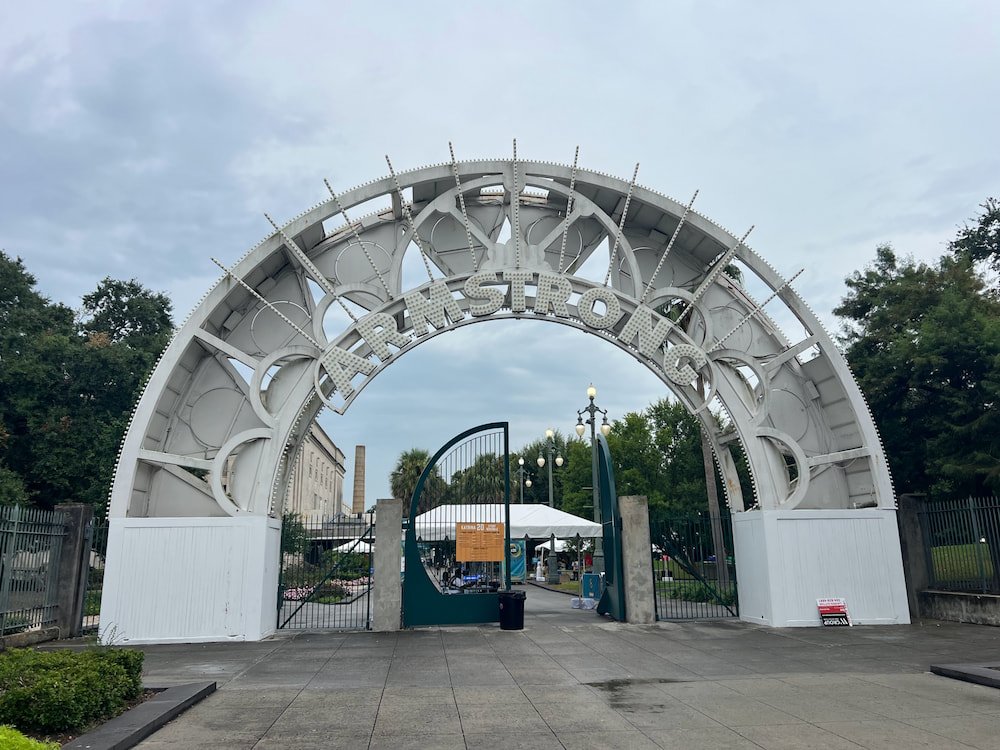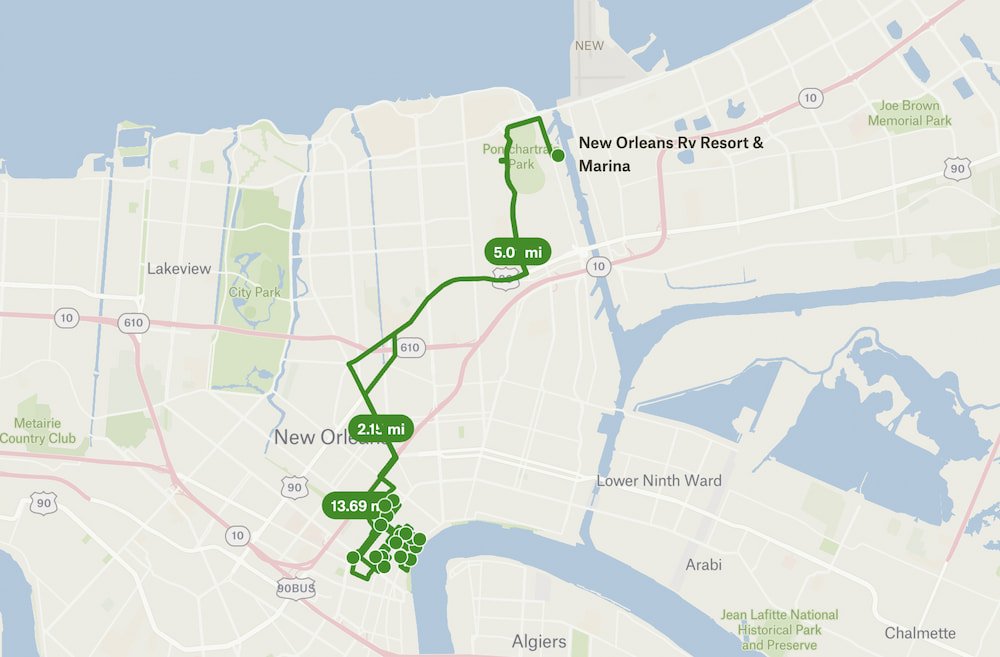While the weather in New Orleans had been hot and humid yesterday, since the RV park is by a marina, the temperatures here had been cooler, and today there would be rain throughout the day. We chilled out in the morning, and once some of the rain subsided, decided to leave Sheila in the coolness of the RV where she'd have air-conditioning, and take one of the eBikes for both of us to head downtown to do some sightseeing.

As we cycled towards downtown, we stopped to see a group of school boys in the midst of band practice outside, playing instruments including drums, trumpets and trombones. They were really good--and it reminded us that it's definitely a New Orleans treat to a second line in a parade, which we saw when we were here last time!
Visiting Tremé
Further along in the Tremé neighborhood, we stopped at the Tomb of the Unknown Slave, which is a huge rusting cross, shackles and chains, resting against Saint Augustine Catholic Church, the only parish whose free people of color bought 2 outer rows of pews exclusively for slaves to use as a place of worship. The memorial was placed here in 2004, dedicated to the slaves who arrived, and noting that there are likely many graves underneath the site of the church as slaves constructed this building, and many tragically died due to disease or other reasons.


Still in Tremé, we saw the Wooden Quilt Doors, which are a collection of patchwork doors standing against a couple of houses created by Jean Marcel St. Jacques, a local artist who survived Hurricane Katrina, and who started making and selling doors that from wood and objects from his damaged home. Some of his works are also on display at the American Folk Art Museum Collection.

We'd been to the nearby Louis Armstrong Park on our last visit, named after the famous jazz trumpeter and singer from New Orleans. As we drew closer to the white arched entrance gates bearing the name "Armstrong", we noticed that there was a program of events listed for the 20th anniversary of Hurricane Katrina, from today (Friday) to Sunday, including talks, gatherings, and musical performances.



We went in, and we got a couple of yellow bandanas, as well as vouchers for free food from the food trucks inside. Lisette got some hush puppies and collard greens from a Creole food truck, and Michael got fried fish and fries from Likkle 14, which served Jamaican and Caribbean food. Both dishes were delicious, and really filling--we don't think we'll need dinner!




We were there relatively early before the events kicked off, so we revisited areas like Congo Square, an open space within the park where enslaved and free people of color gathered for meetings and dancing and drumming in the 1800s, which created and influenced modern jazz music. There's a beautiful sculpture in Congo Square commemorating this history, showing Africans joining each other in dance.

The Festive French Quarter
A stone's throw from Louis Armstrong Park is the French Quarter, one of the most popular places to visit in New Orleans, know for its colorful buildings and nightlife. Its most famous street, Bourbon Street, comes alive every night with bars, clubs, and live music, with all sorts of revelry and debauchery!

We'd walked through the neighborhood and drank at some of the bars here before, but this time we explored on eBike, whizzing through the streets while it was drizzling, seeing the bars start to come alive in the late afternoon. There's a section in the French Quarter that seemed to be mostly gay bars, and it was already buzzing with activity, with men dressed in hot pants, mesh shirts, and Mardi Gras beads spilling out onto the streets. The historic Old Absinthe House was filled with people, with patrons seated in every stool by the bar, and there was live music playing both in bars and by buskers on many street corners.


There's a lot of voodoo in New Orleans, thanks to the city's West African roots (enslaved people brought these traditions from what's now Benin, Togo and Nigeria) as well as its Haitian influence (after the Haitian Revolution at the beginning of the 19th century many people fled to New Orleans). Today, there's places like Marie Laveaus's House of Voodoo and Voodoo Authentica, Both sell all sorts of voodoo items for sale, including masks, statues, potions, dolls, talismans, and other items. Customers can also book to have spiritual readings inside. It's fascinating, if not a little spooky to see all of these items packed in one place!


By the edge of the Mississippi River, we saw the New Orleans Showboat that offers cruises down the water, close to the Monument to the Immigrant, a white marble sculpture that proudly celebrates the city's immigrant roots. And of course, we passed Cafe du Monde, the home of New Orleans' most popular beignets (the busiest store in the city didn't have a line anywhere near what we had encountered on our first trip, where we waited for at least an hour), and the St. Louis Cathedral next to Jackson Square, the oldest Catholic cathedral in the US. It was closed for renovation and we could have sworn this was still the case when we had visited back in 2018.






Wrapping up our bike tour of the French Quarter, we stopped inside the Hotel Monteleone, which has a bar inside that's designed to look exactly like a carousel! It's been around since the 1940s and to this day, it was packed to the rafters with people eager to drink inside. Finally, we paused briefly outside the entrance of the Musical Legends Park, which has statues of historic and iconic performers such as Al "Jumbo" Hirt, Pete Fountain, and Fats Domino in this park that's a popular outdoor musical performance venue.




Seeing Neighborhoods with a Fresh Perspective
Our eBike battery was starting to dwindle rapidly (and Michael's phone battery was done), so we made our way back to the RV park where we were staying for a second and final night. The RV park was located north of downtown, facing Lake Pontchartrain. As we cycled through, with the Hurricane Katrina documentary and the knowledge that we were in town during the 20th anniversary of this event, we couldn't help looking at the neighborhoods that we passed with a fresh pair of eyes.


For example, we passed through the neighborhood of Gentilly on our way back, and this area was heavily affected by the hurricane, experiencing some of the highest water levels after disaster struck. We could still indeed see houses that had signs of water damage on the outside. There were also plenty of homes that looked abandoned and were clearly unable to be fully restored in the aftermath, as many people left the city in the hurricane's wake, never to return.

Once we got back to the RV park, Michael had cycled a total of 31 miles (50 kilometers), so naturally his legs were feeling it! He headed to the pool (even colder than yesterday, which was good shock therapy) to recover, just as the sun was setting, showing off a beautiful and fiery dusk. Our plan is to head into New Orleans tomorrow in the RV, wrapping our visit to the city before continuing on to our next destination.
Route Map

